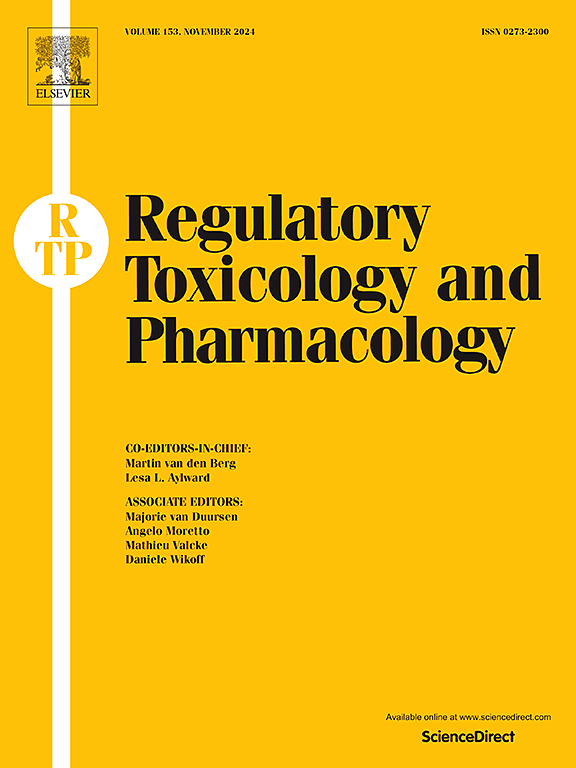Insights into sanguinarine toxicity in Rats: Integrating toxicokinetics, oxidative stress, and gut microbial alterations
IF 3.5
4区 医学
Q1 MEDICINE, LEGAL
引用次数: 0
Abstract
Sanguinarine (SAN), a bioactive benzophenanthridine alkaloid derived from Macleaya cordata, has gained attention as a plant-based pesticide and veterinary therapeutic. However, its toxicity mechanisms, particularly concerning toxicokinetics (TK) and gut microbiota interactions, remain poorly understood. This research assessed the acute and subacute toxicity, toxicokinetics, oxidative stress reactions, and changes in gut microbiota associated with SAN in Sprague-Dawley rats. A single oral dose by gavage resulted in a LD50 of 1000 mg/kg·bw (male) and 926 mg/kg·bw (female), classifying SAN under GHS Category 4. Subacute exposure (14 days at 1/10, 1/50, and 1/100 LD50) induced multi-organ damage, including pulmonary haemorrhage, hepatic steatosis, and renal tubular necrosis, with females exhibiting relatively higher sensitivity. Surviving rats recovered from toxic damage during the 14-day recovery period. Toxicokinetic analysis demonstrated dose-dependent plasma concentration curves, nonlinear elimination kinetics, and tissue accumulation in the liver and kidneys. Assays measuring oxidative stress showed unexpected rises in overall antioxidant capacity alongside marked inhibition of glutathione peroxidase, indicating targeted redox disruption. Gut microbiota sequencing identified dose-dependent dysbiosis: high-dose SAN reduced Firmicutes/Bacteroidetes ratios, depleted Lactobacillus, and enriched opportunistic pathogens (Klebsiella, Streptococcus), alongside altered short-chain fatty acid (SCFA) profiles. These findings underscore SAN's potential to induce systemic toxicity through oxidative stress, metabolic disruption, and gut microbiome-mediated inflammation. The LOEAL observed in this study for subacute exposure (14 days) to SAN was 10 mg/kg and the safe use of SAN should be emphasized.

对大鼠血碱毒性的洞察:整合毒性动力学、氧化应激和肠道微生物改变
血根碱(SAN)是一种具有生物活性的苯并苯胺生物碱,是一种植物性农药和兽药。然而,其毒性机制,特别是有关毒性动力学(TK)和肠道微生物群相互作用,仍然知之甚少。本研究评估了sd大鼠急性和亚急性毒性、毒性动力学、氧化应激反应以及与SAN相关的肠道微生物群变化。单次灌胃给药的LD50为1000 mg/kg·bw(男性)和926 mg/kg·bw(女性),将SAN归类为GHS第4类。亚急性暴露(在1/10、1/50和1/100 LD50下暴露14天)引起多器官损害,包括肺出血、肝脂肪变性和肾小管坏死,女性表现出相对较高的敏感性。存活的大鼠在14天的恢复期内从毒性损伤中恢复。毒代动力学分析显示出剂量依赖的血浆浓度曲线、非线性消除动力学和肝脏和肾脏的组织积累。测量氧化应激的实验显示,总体抗氧化能力出乎意料地上升,同时谷胱甘肽过氧化物酶明显受到抑制,表明有针对性的氧化还原破坏。肠道菌群测序发现了剂量依赖性的生态失调:高剂量SAN降低了厚壁菌门/拟杆菌门的比例,减少了乳酸杆菌,丰富了机会致病菌(克雷伯氏菌,链球菌),同时改变了短链脂肪酸(SCFA)谱。这些发现强调了SAN通过氧化应激、代谢破坏和肠道微生物介导的炎症诱导全身毒性的潜力。本研究中观察到的亚急性(14天)暴露于SAN的LOEAL为10 mg/kg,应强调SAN的安全使用。
本文章由计算机程序翻译,如有差异,请以英文原文为准。
求助全文
约1分钟内获得全文
求助全文
来源期刊
CiteScore
6.70
自引率
8.80%
发文量
147
审稿时长
58 days
期刊介绍:
Regulatory Toxicology and Pharmacology publishes peer reviewed articles that involve the generation, evaluation, and interpretation of experimental animal and human data that are of direct importance and relevance for regulatory authorities with respect to toxicological and pharmacological regulations in society. All peer-reviewed articles that are published should be devoted to improve the protection of human health and environment. Reviews and discussions are welcomed that address legal and/or regulatory decisions with respect to risk assessment and management of toxicological and pharmacological compounds on a scientific basis. It addresses an international readership of scientists, risk assessors and managers, and other professionals active in the field of human and environmental health.
Types of peer-reviewed articles published:
-Original research articles of relevance for regulatory aspects covering aspects including, but not limited to:
1.Factors influencing human sensitivity
2.Exposure science related to risk assessment
3.Alternative toxicological test methods
4.Frameworks for evaluation and integration of data in regulatory evaluations
5.Harmonization across regulatory agencies
6.Read-across methods and evaluations
-Contemporary Reviews on policy related Research issues
-Letters to the Editor
-Guest Editorials (by Invitation)

 求助内容:
求助内容: 应助结果提醒方式:
应助结果提醒方式:


